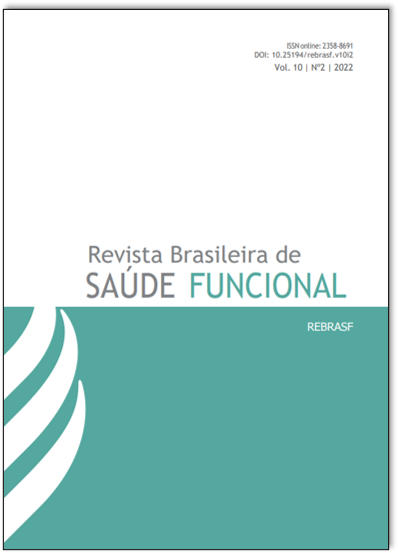EAERLY DIAGNOSIS OF DIABETIC FOOT IN PRIMARY HEALTH CARE
DOI:
https://doi.org/10.25194/rebrasf.v10i2.1378Keywords:
Diabetic Foot, Assessment, Primary Health Care.Abstract
Background: Among the complications that can be triggered by diabetes mellitus, peripheral neuropathy is the most common affection, causing a delay in the speed of conduction of sensitive stimuli, facilitating the occurrence of repetitive traumas making the individual susceptible to plantar ulcers. Objective: To characterize the protective sensitivity of diabetic feet seen in primary care in Recôncavo Baiano. Methods: This is a cross-sectional study with 127 diabetic patients registered in Family Health Strategies. Results: The monofilaments that responded most frequently were lilac, orange and red. The points with the highest degree of sensitivity are represented,by the lilac monofilament at point 1, 44 (34.6%) on the right foot, and on the left foot 49 (34.6%) at points 4 and 8.Followed by the monofilament orange, which on both the right and left feet showed 27 (21.3%) at point 9.The red monofilament with 24 (18.9%) on the right foot and 21 (16.5%) on the left foot, both in the point 9. Conclusion: The characterization of the protective sensitivity of diabetic feet seen in the ESF's in the city of Cachoeira was difficult to discriminate in form and protective sensitivity for the foot.The results suggest the examination and care of the feet by encouraging educational strategies for supported self-care.
Keywords:Diabetic Foot, Assessment, Primary Health Care.
References
Oliveira, JE., Vencio S. Diretrizes da Sociedade Brasileira de Diabetes 2017-2018. São Paulo: Editora Clannad, pag: 91.
Moura EC, Pacheco-Santos LM, Peters LR, Serruya SJ, Guimarães R. Research on chronic noncommunicable diseases in Brazil: meeting the challenges of epidemiologic transition. Rev Panam Salud Publica. 2012;31(3):240–5.
Pedrosa HC, Nery ES, Sena FV et al. O desafio do projeto salvando o pé diabético. Terapia em Diabetes 1998; 4(19): 1-10.
Reiber GE, Lipsky BA, Gibbons GW. The burden of diabetic foot ulcers. Am J Surg 1998; 176(Suppl.2A):5-10.
Bakker K, Apelqvist J, Lipsky BA, Van Netten JJ. The 2015 IWGDF guidance documents on prevention and management of foot problems in diabetes: development of an evidence‐based global consensus. Diabetes Metab Res Rev 2016; 32(Suppl. 1): 2–6. Doi: http://dx.doi.org/10.1002/dmrr.2694.
Bus SA, van Netten JJ, Lavery LA, Monteiro-Soares M, Rasmus- sen A, Jubiz Y et al. IWGDF guidance on the prevention of foot ulcers in at-risk patients with diabetes. Diabetes Metab Res Rev. 2016;32(Suppl 1):16-24.
Assumpção EC, Pitta GB , Macedo ACL, Mendonça GB,Albuquerque LCA , Lyra LCB et al. Comparação dos fatores de risco para amputações maiores e menores em pacientes diabéticos de um Programa de Saúde da Família. J Vasc Bras. 2009;8(2):133-138.
Gomes MB, Gianella D, Faria M, Tambascia M, Fonseca RM, Réa R et al. Prevalence of type 2 diabetic patients within the targets of care guidelines in daily clinical practice: a multi-center study in Brazil. Rev Diabet Stud. 2006;3(2): 82-7.
Ochoa-Vigo K, Pace AE. Pé diabético: estratégias para prevenção. Acta Paul Enferm. 2005; 18(1):100-9.
Brasileiro JL José, Oliveira WTP, Monteiro LB, Chen J, Júnior EPL, Molkenthin S et al. Pé diabético: aspectos clínicos. J Vasc Br 2005;4(1):11-21.
Fajardo CA. importância do cuidado com o pé diabético: ações de prevenção e abordagem clínica Rev Bras Med Fam e Com. 2016;2(5): 43-58.
Gois JPDS, Chaves ASC. Pé diabético: avaliação dos fatores de risco relacionados a amputações maiores e menores. Rev Eletr Acerv Sa.2020; 12(1):1-9.
Bortoletto MSS, Haddad MCL, Karino ME. Pé diabético, uma avaliação sistematizada. Arq.Ciênc.SaúdeUnipar.2009;13(1):37.
Braga DC, Bortolini SM, Rozetti IG, Zarpellon K, Nascimento JC, Neris JE. Avaliação de neuropatia e complicações vasculares em pacientes com diabetes mellitus em um município rural de Santa Catarina. Rev. AMRIGS. 2015;59(2): 78-83.
Patrícia SF, Eduardo F, Carolina MS. Relação entre sensibilidade tátil plantar, idade e IMC com o equilíbrio em sujeitos diabéticos e não diabéticos. Rev. Cient. UMC. 2019;4(1):1-16.
Pecoraro RE, Reiber GE, Burgess EM. Pathways to diabetic limb amputation: basis for prevention. Diabetes Care.1990;13(5):513-21.
Rodrigues FFL, Santos MA , Teixeira CRS , Gonela JT, Zanetti ML.Relação entre conhecimento, atitude, escolaridade e tempo de doença em indivíduos com diabetes mellitus. Acta Paul Enferm. 2012;25(2):284-90.
Miranzi SSC, Ferreira FS, Iwamoto HH, Pereira GA, Miranzi MAS. Qualidade de vida de indivíduos com diabetes mellitus e hipertensão acompanhados por uma equipe de saúde da família. Texto Contexto Enferm. 2008;17(4): 672-9.
Sumpio BE. Foot ulcers. New Engl J Med 2000; 343(11):787-93.
Sacco ICN , Sartor CD, Gomes AA, João SMA,Cronflir R. Avaliação das perdas sensório-motoras do pé e tornozelo decorrentes da neuropatia diabética. Rev. bras. Fisioter.200711(1),27-33.
Ferreira LGF, Torres MV. Análise da correlação entre alterações sensitivas e mobilidade funcional em idosos diabéticos. Rev Fisioter S Fun. Fortaleza. 2013; 2(1): 42-49.
Ferreira RC,Silva APS,Costa MT,Frizzo GG, Santin RAL,Fucs PMMB.Aspectos epidemiológicos das lesões no pé e tornozelo do paciente diabético. Acta Ortop. Bras. 2010;18(3):135-141.
Mendes EV. O cuidado das condições crônicas na atenção primária à saúde: o imperativo da consolidação da estratégia da saúde da família. Brasília. Organização Pan-Americana da Saúde- Representação Brasil. 2012.
Pola HM, Lago OS, Barrientos AM, Santos TF, Santos ND, Caetano JS. Realidade sobre o conhecimento das complicações e do tratamento pelos diabéticos do município de Cachoeira na perspectiva do autocuidado. Rev Bras. Saúde Funcional. 2018;5(2):6-10.


